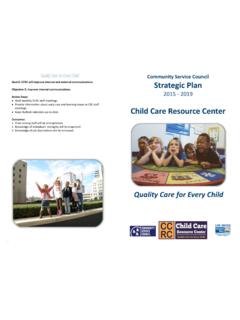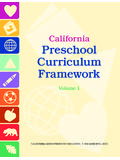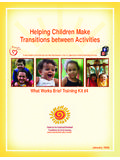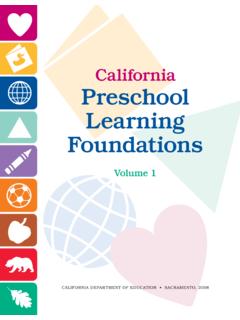Transcription of How to Recognize a Child with Special Needs - First 5 Amador
1 All Children Are Special : How to Know When a Child Needs Help A Manual for Parents and Child care Providers Children s Inclusive care Council of Amador and Calaveras June 2005 The Children s Inclusive care Council of Amador and Calaveras The Children s Inclusive care Council of Amador and Calaveras (CICC) was formed in late 2002 to develop a local plan of action to strengthen the capacity of the Child care community to deliver appropriate, inclusive, high-quality Child care services to families of children with disabilities or other Special Needs . The purpose of the Council is to provide a collaborative framework that will promote and support parents and the Child care network to provide inclusive services for children with Special Needs .
2 The CICC is made up of representatives of the following agencies and organizations: Amador Child care Council Amador County Health Department Amador County Office of Education, Special Education Department Calaveras Child care Council Calaveras County SELPA Calaveras Unified School District, School-Age care Family Resource Network First 5 Amador First 5 Calaveras HRC Calaveras Head Start/State Preschool HRC Child care Resources State Council on Developmental Disabilities (SCDD) - Area Board 6 Valley Mountain Regional Center This manual was printed with funding from First 5 Amador , First 5 Calaveras, and from the California Department of Education, Child Development Division, through SB 1703, courtesy of HRC Child care Resources.
3 2 Table of Contents Introduction 4 Guidelines for Observing Your Child 5 I Have Concerns: What Do I Do Now? 8 Some Things to Think About 10 Who Is a Child with Special Needs ? 11 Putting People First 12 What You Need to Know About Early Intervention & Education Programs 13 Focus on Providers 15 Benefits of Inclusion 16 Strategies for Success 17 The Questions Children Ask 19
4 Appendix 20 Resources 21 Books, Toys & Equipment 23 Sample Letter & Forms 25 3 All Children Are Special : How to Know When a Child Needs Help No one goes very far that you put into the lives of others, comes back into your own. Anonymous Are you a parent who has a Child with a Special need? Or are you a Child care provider with a Child who has a diagnosed disability, or a Child that you suspect might have some kind of developmental delay?
5 Or perhaps you are a Child care provider who would like to be able to care for all children in an inclusive setting and would like to have some help with training and resources. If any of the above descriptions apply to you, this manual was prepared with you in mind. We know that every Child is Special , and some children need Special care because of developmental, physical, health, emotional or behavioral problems. In order to meet the Needs of the Child , it is critical that parents and Child care professionals create and maintain a partnership to help each other help the Child reach his or her full potential. The Children s Inclusive care Council (CICC) of Amador and Calaveras has developed this manual to assist you whatever your role find the help and resources you need for including children with Special Needs in a Child care setting.
6 According to the Child care Law Center, a Child with Special Needs is one who requires some form of Special care due to physical, mental, emotional or health reasons. Because each Child is unique and has unique Needs , no single approach to caring for children with Special Needs can be applied to all children, even those with the same disability or Special need. The practice of inclusion means including children of all abilities in the same classroom or Child care program. Inclusion means a part, not apart. The CICC was formed in late 2002 to develop a local plan of action to strengthen the capacity of the Child care community to deliver appropriate, inclusive, high-quality Child care services to families of children with disabilities or other Special Needs .
7 The purpose of the Council is to provide a collaborative framework that will promote and support parents and the Child care network to provide inclusive services for children with Special Needs . We hope that you will find this information helpful, and that it will assist you in finding the additional resources you may need for that Special Child for whom you care . 4 Guidelines for Observing Your Child Children vary a great deal in what they learn to do and when they learn. Below are some guidelines to follow when observing your Child . If you notice some of these behaviors consistently, you may want to contact or have your Child screened by a professional. VISION Rubs eyes frequently.
8 Seems to have trouble following people or objects with eyes. Has reddened, watering or crusty eyelids. Holds head in a strained or awkward position, tilting it one side or the other, or forward or backward, when looking at an object. Has trouble focusing or making eye contact. Seems to have trouble finding or picking up small objects from floor. Closes one eye when looking at distant objects. HEARING May have frequent earaches. May have frequent ear, nose, or throat infections or allergies. Does not look to the source of voices or react to loud noises by four months of age. Talks in a very loud or very soft voice. May have difficulty responding to a call from across a room.
9 Watches faces intently. Does not use spoken language as expected for his or her age group. Turns up volume on television or toys. Turns body to incline the same ear towards a sound. Has difficulty understanding what is being said. Breathes through the mouth. THINKING By age one, does not respond to faces and objects, or does not Recognize familiar people. Child does not look for hidden object ( peek-a-boo) or does not anticipate return of people. By age two, does not identify simple body parts by pointing, does not match similar objects, or Recognize self in a mirror. Cannot say simple words and name familiar objects. By age three, cannot follow simple directions and commands.
10 Does not imitate adults By age three, does not begin to participate in creative processes; drawing, blocks, or play dough. Cannot match colors and shapes and complete simple puzzles. Unable to pretend or make-believe play. 5 By age four, does not give correct answers to questions, such as; what do you do when you re sleepy/hungry? Does not have an active imagination, cannot sit through a short story. By age four, cannot tell the difference between different shapes and colors, does not pretend to read books. By age five to six, does not understand the concepts of today, tomorrow or yesterday. Cannot follow multiple directions. Cannot sort and match according to different qualities ( shape, color, size).







